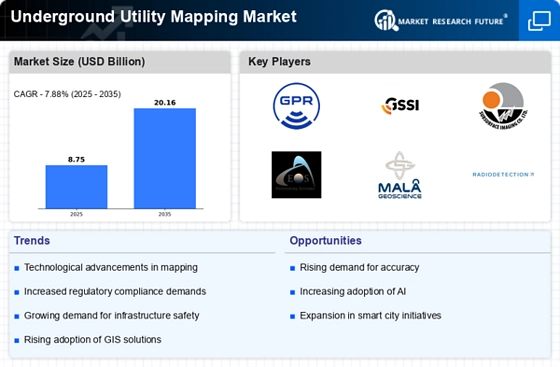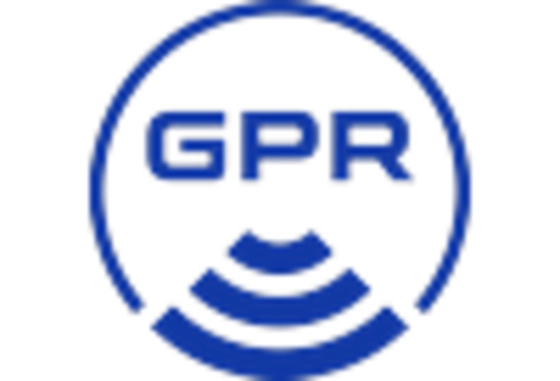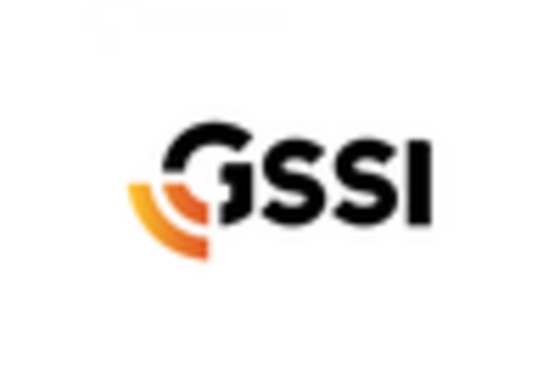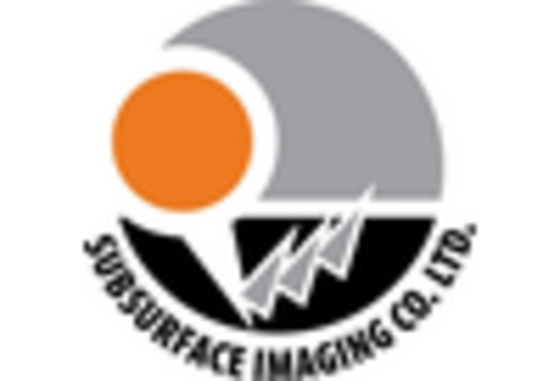Rising Safety Concerns
Safety concerns related to underground utility strikes have become a critical driver for the Underground Utility Mapping Market. With the increasing frequency of accidents resulting from unmarked or misidentified utilities, regulatory bodies are emphasizing the importance of accurate mapping. This heightened awareness has led to stricter compliance requirements for construction and excavation projects. As a result, companies are investing in advanced mapping solutions to ensure safety and minimize liability. The market is projected to grow as organizations prioritize risk management and safety protocols. Estimates suggest that the focus on safety could contribute to a market growth rate of around 12% over the next few years. Thus, the Underground Utility Mapping Market is likely to expand as stakeholders recognize the value of comprehensive utility mapping in safeguarding personnel and infrastructure.
Technological Innovations
Technological advancements in mapping techniques, such as Ground Penetrating Radar (GPR) and electromagnetic flowmeter induction, are revolutionizing the Underground Utility Mapping Market. These innovations enable more accurate and efficient detection of underground utilities, reducing the time and costs associated with traditional methods. The integration of Geographic Information Systems (GIS) with mapping technologies further enhances data visualization and analysis capabilities. As organizations increasingly adopt these advanced tools, the market is expected to experience substantial growth. Reports indicate that the adoption of such technologies could lead to a market expansion of over 15% in the coming years. Consequently, the Underground Utility Mapping Market is likely to see a shift towards more sophisticated solutions that cater to the evolving needs of various sectors, including construction, telecommunications, and energy.
Government Initiatives and Funding
Government initiatives aimed at improving infrastructure and utility management are significantly influencing the Underground Utility Mapping Market. Various governments are allocating funds for projects that require accurate mapping of underground utilities to enhance urban planning and development. These initiatives often include grants and subsidies for adopting advanced mapping technologies, thereby encouraging stakeholders to invest in the Underground Utility Mapping Market. Recent reports indicate that public sector investments in utility mapping could reach billions, further stimulating market growth. As governments prioritize efficient resource management and infrastructure resilience, the demand for precise utility mapping solutions is expected to rise, potentially leading to a market growth rate of 10% or more in the coming years.
Increased Infrastructure Development
The ongoing expansion of infrastructure projects, including roads, bridges, and utilities, drives the demand for the Underground Utility Mapping Market. As urbanization accelerates, the need for precise mapping of underground utilities becomes paramount to avoid costly disruptions during construction. In recent years, the market has witnessed a surge in investments, with estimates suggesting a growth rate of approximately 10% annually. This trend indicates a robust demand for advanced mapping technologies that can accurately identify and document existing underground utilities, thereby enhancing project efficiency and safety. The Underground Utility Mapping Market is thus positioned to benefit significantly from these infrastructure initiatives, as stakeholders seek to mitigate risks associated with utility strikes and ensure compliance with safety regulations.
Growing Demand for Smart City Solutions
The increasing trend towards smart city development is driving the Underground Utility Mapping Market. As cities evolve to incorporate smart technologies, the need for accurate underground utility mapping becomes essential for effective urban management. Smart city initiatives often rely on real-time data and connectivity, necessitating precise mapping of existing utilities to facilitate infrastructure upgrades and maintenance. The market is likely to benefit from this trend, with projections indicating a growth rate of approximately 14% as municipalities invest in smart technologies. The Underground Utility Mapping Market is thus poised to play a crucial role in the successful implementation of smart city projects, ensuring that utility management is efficient and sustainable.


















Leave a Comment